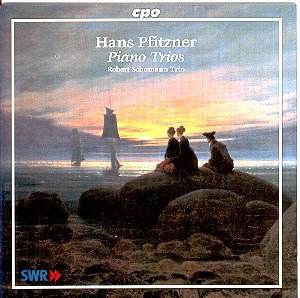
Piano Trios: F, Op. 8 (1896) [44'19]; B flat (1886) [21'01].
Rec. in SWR Studio 5 on November 4th, 1998 (Op. 8); Kleiner Sendesaal, WDR, on November 22nd, 1999 (Trio in B flat). [DDD]
BUY NOW
 |
Hans PFITZNER (1869-1949) Piano Trios: F, Op. 8 (1896) [44'19]; B flat (1886) [21'01]. Rec. in SWR Studio 5 on November 4th, 1998 (Op. 8); Kleiner Sendesaal, WDR, on November 22nd, 1999 (Trio in B flat). [DDD] |
Error processing SSI file |
|
|
||
|
A piano trio by Pfitzner may seem a daunting prospect, especially when the piece in question lasts for three-quarters of an hour (Op. 8): perhaps this was the reasoning behind CPO's 'special price' for this product. That said, it is difficult to imagine anyone with a penchant for late-Romantic music being disappointed by this release. Chamber music was part of the entire gamut of Pfitzner's creative life - his Op. 1 was his Cello Sonata in F sharp minor. The major work on this disc, the Piano Trio in F, Op. 8, dates from 1896; it is the longest composition of his early period. Pfitzner's cup positively overflows with invention. One of his compositional credos was that one idea naturally gives birth to another, and certainly there is a momentum of ideas which makes the eight-minute first movement ('Kräftig und feurig, nicht zu schnell') so compelling. This is in fact true of both of the outer movements (the last movement, 'Rasch und wild', is quite invigorating to listen to). The very opening shows where Pfitzner's 'difficult' reputation comes from. The texture he creates is best described as 'large', full of late-Romantic sweep. But this just emphasises the contrasts Pfitzner is able to call on: try the beautifully calm patch around 5'50, as fragments are exchanged between instruments. All three members of the Robert Schumann Trio get chances to shine. Perhaps it is Kees Hülsmann's sweet-toned violin which should come in for special mention. His sound suits the lyrical basis of this music and he excels himself in the slow movement, which moves to a tender, yet impassioned, climax. The B flat Piano Trio, which dates from 1886, a full decade earlier, is much less demanding fare. The author of the booklet notes, Hans Rectanus, claims to have reconstructed and published the trio from material in the Austrian National Library in Vienna and the Bavarian State Library (Munich). This is the music of youth. The booklet notes accuse the first movement of being 'a little long', something the Robert Schumann Trio set out to disprove: and what a convincing case they make! The second movement is similarly fresh, inspiring the booklet note writer to purple prose. The Romanze 'could be a scene with two lovers. "She" (violin) and "he" (cello) flirt with one another, let go, and finally come to rest in perfect happiness'. Again however, Rectanus feels the third movement Scherzo makes a 'somewhat clumsy impression'. Actually, it is great fun, and the Trio is really affecting. Well worth exploring. Colin Clarke |
|
Return to Index |